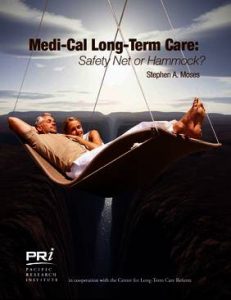On July 1, the federal funds that have propped up California’s troubled Medi-Cal system will disappear. That is only one of the reasons why baby boomers, now retiring in droves, will find Medi-Cal a bust for the long-term care many will need.

Long-term care (LTC) is the medical or custodial assistance people need when they can no longer care fully for themselves. Nearly 70 percent of all people require some LTC and 20 percent need five years or more. LTC is extremely expensive whether provided in a nursing home ($256/day), assisted living facility ($2,576/month) or in one’s own home ($25/hour for an aide).
Historically, government has paid for most LTC through programs like Medi-Cal, Medicare and the Veterans Administration. In 2008, California spent $3.8 billion on nursing homes and $6.5 billion for home health and personal care through Medi-Cal alone.
Medi-Cal is public assistance designed to be a safety net for the poor. It has become a comfy hammock for the middle-class and affluent. Anyone with income below the cost of a nursing home qualifies easily for Medi-Cal-funded LTC. Nor are assets an obstacle because Medi-Cal exempts virtually unlimited resources including up to $750,000 of home equity plus a business, automobile, prepaid burial plans, term life insurance and home furnishings of unlimited value.
For people with even more wealth than Medi-Cal’s generous eligibility rules allow, a cottage industry of specialized “Medi-Cal planners”
manipulate and stretch the elastic rules with special trusts, annuities, life-care contracts and many other sophisticated legal gambits.
In the past, Californians relied on Medi-Cal reluctantly despite its easy eligibility because the program paid primarily for nursing homes, which most people would rather avoid. Over the past three decades, however, Medi-Cal has “rebalanced” to pay mainly for home-based and personal care, which most people prefer.
The effect of easy eligibility and increasingly attractive services – including even Medi-Cal payments for friends or relatives to provide home care – has been to anesthetize the public to LTC risk and cost. Consequently, private-pay for LTC has declined precipitously and only 5.4percent of Californians age 50-plus have purchased private LTC insurance.
Medi-Cal costs have been soaring, and California’s foundering economy is ill-equipped to pay the bills. With an aging population drifting toward senescence, who will pay for long-term care in the future? Only one thing is certain: it won’t be the state and federal governments which now share the cost of Medi-Cal, at least not at anything like the current level.
Budget challenges have forced Medi-Cal to cut back on home care and adult day health programs. Californians should expect such cuts to continue and increase after July 1, when supplemental federal matching funds that have propped up the program since October 2008 disappear.
California will then have no choice but to cut popular benefits, tighten Medi-Cal eligibility rules, close gaping “loopholes,” strengthen recovery from deceased recipients’ estates, and encourage personal responsibility for LTC through greater asset spend-down, home equity conversion, and private insurance.
As Medi-Cal LTC backs off, more families will have to pay for their own long-term care. When their savings run out, homeowners will turn to reverse mortgages to fund home care. More people will buy private LTC insurance as the consequences of “going bare” become increasingly severe and obvious. On the other hand, when more Californians pay their own way, access to long-term care will improve, along with its quality.
Currently Medi-Cal LTC attempts to provide too much for too many, failing the very ones for whom it was supposed to provide a safety net. California legislators should redesign Medi-Cal with those realities in mind, and do it sooner rather than later. In 2011, a baby boomer turns 65 every eight seconds.
Stephen A. Moses is president of the Center for Long-Term Care Reform (www.centerltc.com) and author of the forthcoming “Medi-Cal Long-Term Care: Safety Net or Hammock?” from the Pacific Research Institute (www.pacificresearch.org).
